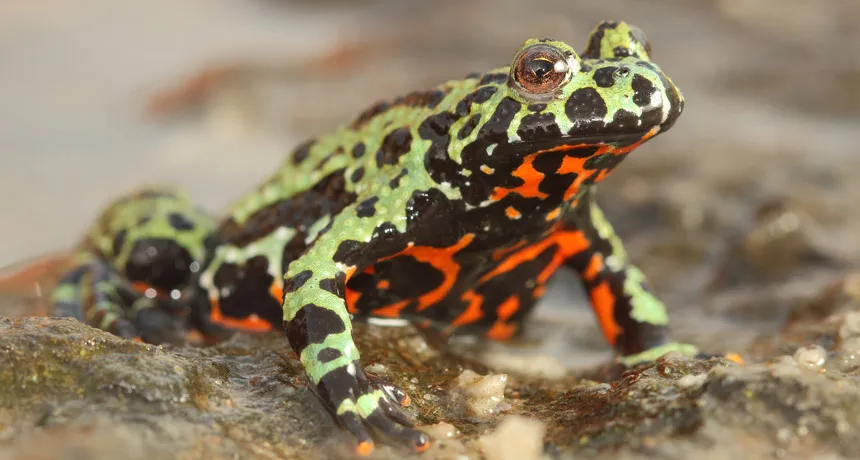
RISKY TRAVELER A genetic study now traces an amphibian-killing fungus to East Asia, from where international trade in such showy pets as this oriental fire-bellied toad could have helped launch the pathogen worldwide.
Frank Pasmans
The biggest genetic study yet of a notorious frog-killing fungus says it probably originated in East Asia in the 20th century.
The chytrid fungus nicknamed Bd, which attacks the skin, has astonished biologists in the last several decades by causing sudden, mass die-offs among frogs and other amphibians in Australia, Panama and other places worldwide. But where and when the killer emerged and how it spread have been much-debated mysteries. Studies have proposed North and South America as well as Africa and Asia as the homeland where a once-obscure fungus turned deadly.
Building up enough genetic data to untangle the origins has taken some 10 years of field and lab work at about 35 institutions around the world, says infectious disease epidemiologist Simon O’Hanlon of Imperial College London. Analyzing the trove finds four main lineages of the fungus Batrachochytrium dendrobatidis and reveals that the worldwide killer group, BdGPL, probably originated 50 to 120 years ago, the researchers say.
How the fungus traveled far and fast is less of a mystery. All the lineages show up in animals that have been traded internationally, often as exotic pets, the team reports in the May 11 Science.
That’s “one of the parts I found most worrisome,” says longtime Bd researcher Karen Lips of the University of Maryland in College Park, who was not involved in the new study. International standards for pathogen monitoring are only as strong as their enforcement. “Here in the U.S. there is no requirement for testing of imports for chytrids,” she says.
Follow the fungus
Very similar forms of the Bd fungus show up in places too far apart for the animals to have hopped, swum or crawled without human help. Suspicion falls on the international trade in amphibians. Lines color-coded for the four main lineages of the fungus link far-flung places where genetic details of the fungus show close similarities. Black diamonds give examples of some of the places where researchers collected a lineage of the Bd fungus from particular amphibian species that had been traded.

Spread of known lineages is only one of her worries. Mingling animals with different infections around the world could encourage current fungi to mate and create new forms. The new study has already found an example of one Bd hybrid.
Bd may now be one of the most discussed fungal killers of animals in the world. It didn’t even have a name, however, when biologists were growing alarmed in the 1990s about amphibian declines and spooky die-offs. The fungus showed up now and then as researchers searched for the killer pathogen, but was dismissed at first as a skin fungus taking advantage of a dying animal. At the time, chytrids were mostly little-studied fungi that did little-known things in soils and water as far as the world’s small community of specialists knew. The idea of a chytrid, or any other fungus, causing an animal pandemic was odd.
By the time researchers gave the newfound menace its official name in 1999, the killer lineage of Bd was spreading around the world. Various sleuthing efforts to backtrack its spread have yielded the far-flung possible origins as well as extremes of time; one study calculated that the deadly form had originated 26,400 years ago.
In the new study, the team determined the arrangement of DNA building blocks in 177 individual samples of Bd from around the world, including the first ones available from Korea and Taiwan. Adding in some earlier collections, the new study draws on information from 234 individual samples.
People who haven’t tried isolating one fungus’s DNA in full from wild amphibians underestimate the difficulty, O’Hanlon says. For instance, study coauthor Matthew Fisher of Imperial College London and colleagues caught and sampled about 500 amphibians during field work in French Guiana to score just three usable versions of full DNA in later lab work.
Comparing the DNA samples let researchers rough out a genealogical tree with the four main Bd lineages, including a previously unknown one from Korea now dubbed BdASIA-1. For several reasons, that one appears to be the closest yet found to the original ancestor, the researchers propose. BdASIA-1 shows exceptional genetic variety, for example, something biologists expect from an original genetic pool that has sent out various emigrant versions. The Asian origin also fits with current thinking about the source of a sister chytrid, B. salamandrivorans, which is spreading into Europe and killing salamanders.
Still, other places in East Asia might turn out to have Bd lineages that are even older than the Korean BdASIA-1, O’Hanlon says. There aren’t that many East Asian samples in the current database, and none at all come from India. This study may have corralled the most samples yet, but resolving the Bd origins mystery in detail is going to take even more.






